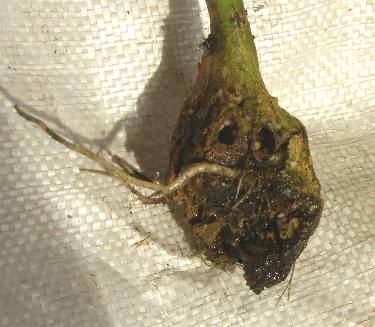
This cauliflower root has an advanced case of club root. Secondary wet rot and slugs have also joined in.
Most of the Cruciferae Family
which includes all of the brassica are affected. The roots become stubby and swollen and
can develop wet rot. This greatly reduces the function of the roots causing the leaves to become yellow and a severe stunting of growth. In dry conditions the leaves will wilt.
Moist, warm acid
soils are more favoured by the fungus. The spores enter
the root hairs and the fungus develops as a jelly-like
mass (plasmodium) not as hyphae. This causes swelling
and reduces the flow of water and nutrients to the
plant. Resting spores are produced as the root rots and can
survive in the soil for up to fifteen years. This means that even rotating crops on the usual four year cycle will not avoid the problem.
Some ornamental plants such as stocks, allysum and wallflowers are also in the Family Cruciferae and are susceptible to attack, as is the common weed Shepherds
Purse. The growth and flowering are affected and they will be an alternate host which could bring the disease to the garden on transplants.
- Sowing crops in the autumn when the soil is cooler reduces the risk of attack.
- Raising your own plants from seed should avoid the chance of bringing in the disease on transplants.
- Plants raised in individual 7.5cm pots
using fresh soil-based compost produce a good root
system which can survive an attack after planting out.
- If a pocket of soil is removed from infested ground and replaced with a mixture of garden compost, blood,fish and bone fertilizer and lime, the plants may not be affected.
- The spores can be moved to other areas in soil, on tools and the soles of shoes, so care and hygiene are important if the disease is present.
- There is no complete treatment for
infected plants which should be burnt.
- Liming to reduce the acidity of the soil and dipping
transplants in a fungicide like flowers of sulphur, should discourage attack.
- Cabbage Kilaxy and Cauliflower Clarify are
two varieties that are resistant to most clubroot strains.
Back to article on Plant Diseases or use the back button of your browser.